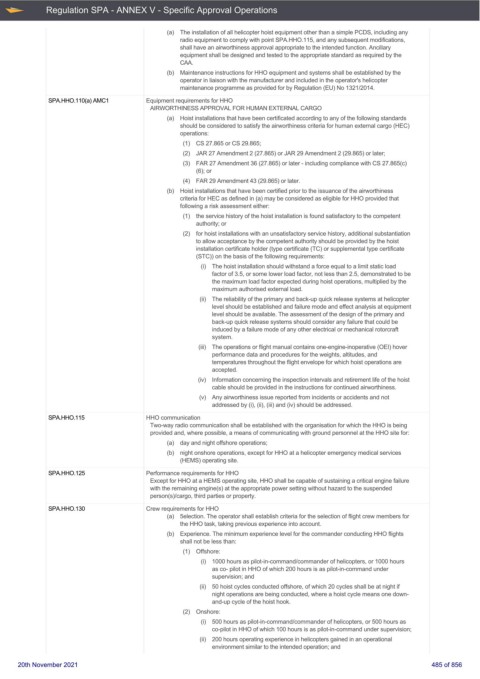Page 485 - UK Air Operations Regulations 201121
P. 485
~
~ Regulation SPA - ANNEX V - Specific Approval Operations Centrik
(a) The installation of all helicopter hoist equipment other than a simple PCDS, including any
radio equipment to comply with point SPA.HHO.115, and any subsequent modifications,
shall have an airworthiness approval appropriate to the intended function. Ancillary
equipment shall be designed and tested to the appropriate standard as required by the
CAA.
(b) Maintenance instructions for HHO equipment and systems shall be established by the
operator in liaison with the manufacturer and included in the operator's helicopter
maintenance programme as provided for by Regulation (EU) No 1321/2014.
SPA.HHO.110(a) AMC1 Equipment requirements for HHO
AIRWORTHINESS APPROVAL FOR HUMAN EXTERNAL CARGO
(a) Hoist installations that have been certificated according to any of the following standards
should be considered to satisfy the airworthiness criteria for human external cargo (HEC)
operations:
(1) CS 27.865 or CS 29.865;
(2) JAR 27 Amendment 2 (27.865) or JAR 29 Amendment 2 (29.865) or later;
(3) FAR 27 Amendment 36 (27.865) or later - including compliance with CS 27.865(c)
(6); or
(4) FAR 29 Amendment 43 (29.865) or later.
(b) Hoist installations that have been certified prior to the issuance of the airworthiness
criteria for HEC as defined in (a) may be considered as eligible for HHO provided that
following a risk assessment either:
(1) the service history of the hoist installation is found satisfactory to the competent
authority; or
(2) for hoist installations with an unsatisfactory service history, additional substantiation
to allow acceptance by the competent authority should be provided by the hoist
installation certificate holder (type certificate (TC) or supplemental type certificate
(STC)) on the basis of the following requirements:
(i) The hoist installation should withstand a force equal to a limit static load
factor of 3.5, or some lower load factor, not less than 2.5, demonstrated to be
the maximum load factor expected during hoist operations, multiplied by the
maximum authorised external load.
(ii) The reliability of the primary and back-up quick release systems at helicopter
level should be established and failure mode and effect analysis at equipment
level should be available. The assessment of the design of the primary and
back-up quick release systems should consider any failure that could be
induced by a failure mode of any other electrical or mechanical rotorcraft
system.
(iii) The operations or flight manual contains one-engine-inoperative (OEI) hover
performance data and procedures for the weights, altitudes, and
temperatures throughout the flight envelope for which hoist operations are
accepted.
(iv) Information concerning the inspection intervals and retirement life of the hoist
cable should be provided in the instructions for continued airworthiness.
(v) Any airworthiness issue reported from incidents or accidents and not
addressed by (i), (ii), (iii) and (iv) should be addressed.
SPA.HHO.115 HHO communication
Two-way radio communication shall be established with the organisation for which the HHO is being
provided and, where possible, a means of communicating with ground personnel at the HHO site for:
(a) day and night offshore operations;
(b) night onshore operations, except for HHO at a helicopter emergency medical services
(HEMS) operating site.
SPA.HHO.125 Performance requirements for HHO
Except for HHO at a HEMS operating site, HHO shall be capable of sustaining a critical engine failure
with the remaining engine(s) at the appropriate power setting without hazard to the suspended
person(s)/cargo, third parties or property.
SPA.HHO.130 Crew requirements for HHO
(a) 5election. The operator shall establish criteria for the selection of flight crew members for
the HHO task, taking previous experience into account.
(b) Experience. The minimum experience level for the commander conducting HHO flights
shall not be less than:
(1) Offshore:
(i) 1000 hours as pilot-in-command/commander of helicopters, or 1000 hours
as co- pilot in HHO of which 200 hours is as pilot-in-command under
supervision; and
(ii) 50 hoist cycles conducted offshore, of which 20 cycles shall be at night if
night operations are being conducted, where a hoist cycle means one down-
and-up cycle of the hoist hook.
(2) Onshore:
(i) 500 hours as pilot-in-command/commander of helicopters, or 500 hours as
co-pilot in HHO of which 100 hours is as pilot-in-command under supervision;
(ii) 200 hours operating experience in helicopters gained in an operational
environment similar to the intended operation; and
20th November 2021 485 of 856

